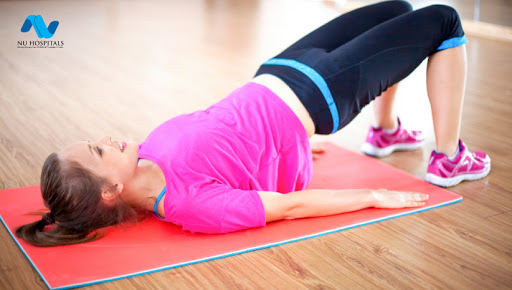Pelvic floor muscles are those set of muscles that support your uterus, bladder, small intestine, and rectum. When they’re working like they should, your pelvic floor muscles may never cross your mind. But over time, due to advancing age and various other factors, these muscles can start to weaken resulting in incontinence. Incontinence means leakage of urine (pee) or stool (poop) that you can’t control. Doing Kegel exercises can help strengthen your pelvic floor muscles. This can help you manage or prevent physical problems like incontinence. Kegel’s exercises are also known as pelvic floor exercises. It is named after Dr. Arnold H Kegel who described this in 1952.
What is the pelvic floor?
The pelvic floor is composed of a thin sheet of muscular fibers and associated connective tissue which spans like a hammock underneath the pelvis and supports the Urinary bladder, Rectum, and Vagina with the uterus. (See illustration below).


What if my pelvic floor muscles are weak?
The weakness of the pelvic floor muscles may cause or worsen a number of problems
- Urge incontinence: Urine leaks before reaching the desired place & time.
- Stress incontinence: Leaks on stress or an increase in abdominal pressure.
- Mixed urgency and stress incontinence: A combination of both stress and urge.
- Pelvic Organ prolapse: Displacement of pelvic organs out of their destined place.
What are the benefits of pelvic floor exercises?

How to exercise your pelvic floor muscles?
It is important to learn to do the exercises in the right way and to check from time to time that you are still doing them correctly. Your Doctor/ physiotherapist can help you to understand this by using diagrams, drawings, and models.
- In the upright position, sit comfortably with your feet and knees wide apart. If preferred, you can also lie down flat with your legs slightly apart. Remember to keep breathing throughout and keep your stomach, leg, and buttock muscles relaxed.
- Squeeze the muscles around your anus and vagina as if you are trying to stop yourself from passing gas from the bowel and at the same time trying to stop the flow of urine from the bladder. You should feel a lifting and tightening around the vagina and anus when you do this.
- Observing the muscles can be an effective way of checking whether they are working correctly.
Lie propped on the bed; place a small mirror between your legs with your knees bent and apart. As you pull up the pelvic floor you should see your anus and entrance to the vagina lifting and drawing in.
Note: If you notice that your entrance of the vagina widens or if you leak urine or pass gas when doing these exercises, it is likely that you are pushing down not pulling up. You may not be able to immediately identify the contract and relax adequately at first. Don’t be disappointed. You will need to be trained by experts during the first and subsequent visits.
How often should I practice?
There two types of exercises
- First, tighten your pelvic floor muscles as described above without using your buttocks or thigh muscles. Hold tight for 5 seconds or as much as you can (up to a maximum of 10 seconds). Release the contraction and rest for at least the same time of the contraction. Repeat the ‘tighten, hold and release’ as many times as you can (up to a maximum of 8-10 repetitions). These are called as sustained contractions.
- Second, perform the pelvic floor exercise but squeeze quickly and then let go. Rest 1-2 seconds before the next one. These are called quick contractions.
Exercises can be done in any position but it will be more effective if done in the below-mentioned positions. Do such 8-10 such repetitions in each of the positions mentioned below, 3 times a day for at least 6 months.


What are the precautions?
- Ask your therapist whether you are squeezing the right muscles
- Always tighten and contract your pelvic muscles before coughing, sneezing, jumping, or lifting to help prevent incontinence.
- Try to maintain your weight within healthy limits.
- Don’t overdo it. Fatiguing the pelvic floor can make it unable to fulfill its functions.
- If you feel pain in your abdomen or back after practicing your exercise, you are most likely doing them incorrectly. Make sure that while practicing your Kegels, your back, buttocks, abdomen, and thighs remain relaxed.
- If you have trouble finding your pelvic floor, feel any pain during these exercises, or don’t notice any improvements, make sure to check in with your doctor.
